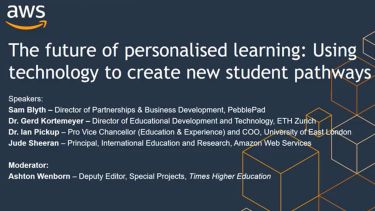Video conferencing and giant data repositories offer a blended research model that encourages knowledge sharing anywhere in the world
The Covid-19 pandemic pushed research online and has ushered in a new era of digital collaboration, said the panellists of a Times Higher Education webinar, held in partnership with Amazon Web Services.
“The world is increasingly digital, and most work is done on some kind of digital form of data,” said Bruno Silva, technical business development manager at Amazon Web Services. “It’s really important that there is some kind of globally available infrastructure, a globally available service, that can support [research] collaborations, not just within countries, but across countries, across continents.”
The pandemic accelerated this digital research revolution, said Nick Plant, deputy vice-chancellor for research and innovation at the University of Leeds. “We’ve seen the writing on the wall for a number of years,” he said. “The sort of large-scale challenges that we have to face have driven us towards collaborating and really only by working in those larger teams can we hope to address some of the big challenges.”
The University of Leeds is part of Future Climate for Africa, a research and innovation project that aims to enhance climate prediction and modelling across the continent. The project requires petabytes of data storage, as well as the computational power to analyse the data, Professor Plant said. Digital innovation has been vital in allowing all collaborators to work on the data despite being in different locations.
Remote access to giant data repositories will continue even once the pandemic is over, said Mavi Sanchez-Vives, co-director of the EVENT (Experimental Virtual Environments in Neuroscience and Technology) Lab at the University of Barcelona. Professor Sanchez-Vives is involved in the Human Brain Project, which aims to understand brain networks and their role in cognition and consciousness. The pandemic has sped up the development of a platform to allow researchers to share data and create a pipeline for data analysis, she said.
Seeing the need for such platforms, Amazon Web Services developed AWS Snowmobile, an exabyte-scale data transfer service used to move extremely large amounts of data, said Dr Silva. “The cloud is gearing up for very large data sets.”
The rapid and necessary uptake of video conferencing platforms has also changed the way researchers interact. “Researchers have very quickly moved online,” said Ying Chen, head of research and knowledge exchange delivery at SOAS University of London. “Our research involves lots of international collaborators in Africa, Asia and Middle Eastern countries,” she said, noting that research was seriously affected at the start of the Covid-19 crisis.
While moving online allowed researchers to continue with their work, Dr Chen believes that technology will not replace fieldwork, which not only allows academics to undertake research in their disciplines but to collaborate with other researchers. She foresees higher education institutions implementing blended research, in the same way that they have turned to blended learning.
But there are benefits to having more online interactions and digital collaborations. Online meetings and conferences have meant that academics travel less, reducing their carbon footprint and expenses, Dr Chen said.
Professor Sanchez-Vives said that the evolution of virtual reality technology may overcome some of the challenges of interacting online. This would allow researchers to “inhabit” the same space, even though they are separated by thousands of kilometres.
However, the overarching challenge in the digital collaboration space is the proliferation of different technologies that do not speak to each other, said the panellists. “I think the challenge is to make sure that it’s easily interchangeable and that people actually understand the potential,” said Professor Plant.
Dr Chen agreed, saying that having so many technology platforms with multiple collaborators was a problem: “It’s like there are files and data scattered everywhere; it’s a challenge.”
Dr Silva said this was why Amazon Web Services tried, where possible, to use open protocols and standards, so that its services spoke to other platforms, making it easier for researchers across the world to share their knowledge.
Find out more about Amazon Web Services’ work in the public sector.








